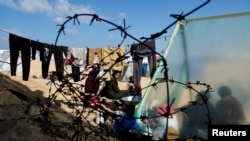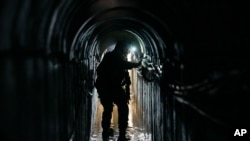Israeli Prime Minister Benjamin Netanyahu is promising “safe passage” for tens of thousands of Palestinians out of Gaza’s southernmost town of Rafah ahead of a planned Israeli ground offensive against Hamas militants; It is not clear, however, where the displaced Palestinians will go.
Netanyahu, in an interview broadcast Sunday on ABC’s “This Week” show, reiterated his intention to order Israeli troops to attack four Hamas battalions in Rafah, saying victory cannot be achieved over the militants in Gaza without clearing them out of the town on the Egyptian border.
With more than half of Gaza’s 2.3 million people crammed into the far southern reaches of the territory, international critics of Netanyahu have expressed alarm at the prospect of an Israeli ground assault.
But the Israeli leader said, "We're going to do it. We're going to do it while providing safe passage for the civilian population so they can leave."
Watch related report by Veronica Balderas Iglesias:
When asked where the Palestinians — many already sheltering in makeshift tents — would go, Netanyahu said only that Israeli officials are "working out a detailed plan."
Some world officials are expressing deep concerns about the Israeli war plan in Rafah and its promise of safety for the Palestinians there.
President Joe Biden spoke to Netanyahu by phone Sunday and told him Israel shouldn’t go forward with a military operation in Rafah without “a credible and executable plan for ensuring the safety of and support for the more than one million people sheltering there,” a White House statement said.
U.N. Secretary-General Antonio Guterres said there would be the risk of a "gigantic tragedy" if the Israel Defense Forces expand their offensive into the town.
“We would not support in any way forced displacement, which goes against international law,” Guterres’ spokesperson told reporters Friday about a potential evacuation of Rafah.
Biden, who has supported Israel’s right to defend itself following the October 7 Hamas terror attack, said last week that nonetheless the Israeli military campaign in Gaza is “over the top.”
German Foreign Minister Annalena Baerbock wrote on social media platform X, "The people in Gaza cannot disappear into thin air," adding that an Israeli offensive on Rafah would be a "humanitarian catastrophe in the making."
Saudi Arabia's foreign ministry warned Saturday of "very serious repercussions of storming and targeting" Rafah and called for an urgent U.N. Security Council meeting. British Foreign Secretary David Cameron said he is "deeply concerned" about the prospective offensive.
"The priority must be an immediate pause in the fighting to get aid in and hostages out," he wrote on X.
An Israeli ground offensive into Rafah could have other repercussions as well.
Hamas-run Al-Aqsa television quoted a senior Hamas official as saying any Israeli ground offensive into Rafah would "blow up" negotiations for a halt in the fighting and the possible release of about 100 hostages held by the militants.
Even with a looming ground offensive, Israeli airstrikes have targeted Rafah. The Associated Press, citing health officials and eyewitnesses, reported at least 44 people were killed Saturday — including more than a dozen children — when air attacks hit several homes in the Rafah area.
Hamas has been designated a terror group by the United States, Britain and the European Union. The war in Gaza started with the October attack that killed 1,200 people in Israel and led to the capture of 240 hostages, about 100 of whom were released in a weeklong cease-fire in November. Hamas health officials say Israel’s counteroffensive in Gaza has killed more than 28,000 people.
Egyptian officials have warned that any ground operation in Rafah or mass displacement across the border would undermine its 40-year-old peace treaty with Israel.
It is also the main humanitarian aid entry point to Gaza and intense fighting could further hamper relief efforts.
Egypt's foreign minister, Sameh Shoukry, warned that any Israeli ground offensive on Rafah would have “disastrous consequences,” claiming that Israel aims to eventually force the Palestinians out of their land.
The dire humanitarian situation has sparked Arab and U.N. concerns that Palestinians may eventually be driven over the border. Egypt has sent about 40 tanks and armored personnel carriers to northeastern Sinai within the past two weeks as part of a series of measures to bolster security on its border with Gaza, two Egyptian security sources said.
Gaza tunnels
The Israeli military says it has discovered a tunnel network hundreds of meters long, extending partly under the Gaza headquarters of the United Nations’ relief agency for Palestinians.
Israeli army engineers took reporters from foreign news outlets through the tunnels. They entered a shaft next to a school on the periphery of the U.N. compound, descending to the concrete-lined tunnel.
After 20 minutes of walking through the hot, narrow and occasionally winding passage, they were underneath the relief agency headquarters, according to an army lieutenant-colonel leading the tour.
The military said the tunnel was 700 meters long, 18 meters deep, bifurcated at times, and it revealed side-rooms. There was an office space, with steel safes that had been opened and emptied. There was a tiled toilet. One large chamber was packed with computer servers, and another with industrial battery stacks.
“Everything is conducted from here. All the energy for the tunnels, which you walked through them are powered from here," said the lieutenant-colonel, who gave only his first name, Ido.
Ido said Hamas militants appeared to have evacuated when the IDF was advancing. He said they preemptively cut communications cables, which he showed, that ran through the floor of the basement of the relief agency headquarters.
It appeared that heavy Israeli barrages and sustained winter rains also may have played a part in the militants’ departure. Several stretches of the tunnel were clogged with dislodged sand and knee-high water.
After the discovery of the tunnel, Israeli Foreign Minister Israel Katz posted on X, a call for the resignation of Philippe Lazzarini, the commissioner-general of the relief agency.
Katz dismissed Lazzarini’s claim that he was unaware of the tunnel’s existence as “not only absurd but also an affront to common sense.”
In a statement, the U.N. Relief and Works Agency, UNRWA, said it had vacated the headquarters on October 12, five days after the terror attack occurred, and was therefore "unable to confirm or otherwise comment" on the Israeli finding.
This is a time of internal crisis for the U.N. relief agency, which is facing Israeli allegations that 12 of its staff aided the October attack. The agency has launched an internal probe into the claims, and several donor countries, including the U.S., have frozen their funding.
Some information for this story came from The Associated Press, Agence France-Presse and Reuters.











